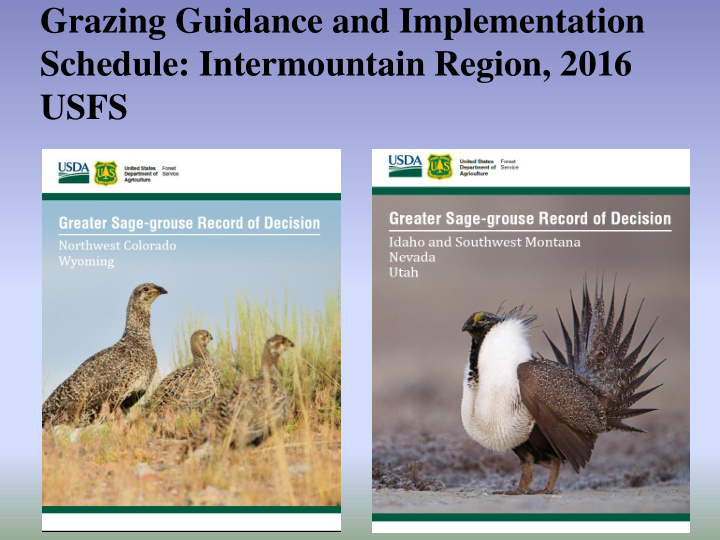



Grazing Guidance and Implementation Schedule: Intermountain Region, 2016 USFS
Scope of Implementation…. R-4 Centric Includes 5 Western States in the Intermountain Region – including the Bridger-Teton Forest in Wyoming Bi-State Direction for California and Nevada available in December, 2016 Cross-regional applicability
Sage Grouse Implementation Team
Technical Teams These require interagency Grazing emphasizes State, NGO, cooperation and Permittee Cooperation
Grazing Implementation: Key Objectives…… • Implement Key Grazing Guidelines and Desired Conditions (DCs) incorporated in R-4 RODs for Greater and Bi-State Sage-grouse Conservation • Provide for Continued Grazing on affected USFS grazing allotments to meet management objectives incorporated in R-4 RODs. • Monitor and validate the long-term efficacy of Grazing Guidelines through grazing • Adaptive Management: Identify and implement adjustments in grazing management needed to meet DCs and Management Objectives in regional ROD’s
Grazing Management: Assessment and Implementation Protocols…. • Vegetation Assessment Protocol • Where does What Apply? (FY 2016) • Identification/Validation of Suitable Sage-grouse Habitat (ROD’s) on Regional Grazing Allotments and Pastures • Regional Random Sampling Design…… • HAF Inventory Assessment • Training/Assessment/Collaboration with Agency Partners
Grazing Management: Assessment and Implementation (continued...) Regional Application of Grazing Guidelines… • Modification of Grazing Permits and AMP’s • Phased Approach… • Phase I (2017) • Incorporation of Grazing Guidelines and DCs (RODs) in affected Grazing Permits • Annual Operating Instructions • Implementation of Grazing Guidelines • Inventory and Monitoring • Phase II (Where needed…) • Identification of Adaptive Management needs for Grazing • NEPA? • Permit Modifications for Adaptive Management
Implementation of Grazing Guidelines...Key Features affecting Agency Grazing Permittees • Required involvement of Forest Grazing Permittees in the Implementation Process • No Adverse impacts to current permits through Phase I Permit Modifications • Suspension of Non-Compliance actions where Grazing Permittees are actively involved in Implementation and Adaptive Management Process
Grazing Implementation Schedule...Key Milestones. • 3 – Year Phased Implementation of Grazing Guidelines • 2016 - Evaluation of Suitable Habitat and determination of affected grazing allotments and permits • 2017 – Initial modification of Regional Grazing Permits (Region-wide) • Initiation in January 2017 • Consideration of Grazing Appeals • 2018 – Identification of Adaptive Management needed to comply with RODs and provide for continued grazing • 2019 and beyond - Implementation/Monitoring • 2020 – Implementation Reporting to USFWS
Desired Conditions…Key Point! “Priority management areas and general management areas may contain non-habitat, but management direction would not apply to those areas of non-habitat. However, management direction would apply to all areas within sagebrush focal areas including non- habitat .”
Prescriptive Guidance GRSG-LG-ST-034-Standard – In priority habitat management areas, do not approve construction of water developments unless beneficial to greater sage-grouse habitat. GRSG-LG-GL-037-Guideline – Bedding sheep and placing camps within 1.2 miles from the perimeter of a lek during lekking (from March 1 to April 30) should be restricted. GRSG-LG-GL-038-Guideline – During the breeding and nesting season (from March 1 to June 15), trailing livestock through breeding and nesting habitat should be minimized.
Achieving Desired conditions
Prescriptive Guidance GRSG-LG-GL-035-Guideline – …If values…cannot be achieved based upon a site-specific analysis using Ecological Site Descriptions, long-term ecological site potential analysis, or other similar analysis, adjust grazing management to move towards desired habitat conditions
Achieving Desired Conditions Livestock Grazing Grazing guidelines will apply in GRSG habitat on NFS lands within a buffer distance (state dependent) Phased-in approach within 18-24 months for the majority of our allotments. Some circumstances up to 36 months may be required for permit modification and full implementation. No immediate changes, will work with permittee
This year’s budget process • Lump handed down from WO • Identifying “shelf - stock”, appropriate accordingly • Identify capacity, appropriate accordingly • Identify better future process
Mitigation The Forest Service will participate with the BLM to establish a Western Association of Fish and Wildlife Agencies (WAFWA) Management Zone Greater Sage- Grouse Conservation Team… --22 December, BLM deadline …to develop a WAFWA Management Zone Regional Mitigation Strategy --22 September, 2016, BLM deadline …to align with existing efforts…mitigation managed at a state-level
Adaptive Management During implementation...inter-agency teams in Idaho, Southwest Montana, Nevada, Utah, and Wyoming will evaluate the key metrics for populations and habitat on an annual basis The working group will…recommend adjustment to management activities…
Next Steps…… Prescriptive guidance will be fluid and subject to evaluation and adaptive management over time… Basic guides completed by April 2016 Grazing range evaluation through 2018 Create needed connections with states and BLM Mitigation, Adaptive Management ASAP Form WAFWA management zones
Recommend
More recommend